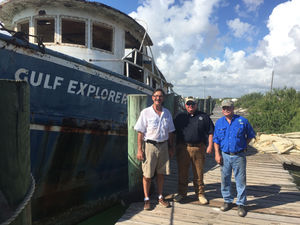An artificial reef project aimed at boosting red snapper populations in South Texas waters hit a major milestone this past week with the issuance of a final permit from the U.S. Army Corps of Engineers.
The recipient was Friends of RGV Reef, which may now proceed with sinking the reef’s first vessel. Gary Glick, the group’s president, said the retired trawler Gulf Explorer will be sent to the bottom in state waters 13.75 nautical miles north of the South Padre Island jetties and eight nautical miles offshore, likely next month.
The group got a good deal on the 30-ton shrimper — plus a retired ocean-going tugboat also slated for sinking — from Billy Kennon of Marine Salvage & Services Inc. in Port Isabel, Glick said.
“He gave a steep discount to Friends of RGV Reef because he knew the good they could do for the community,” he said. “This was a great boon to Friends of RGV Reef.” Both vessels had to be thoroughly cleaned before authorities would issue the necessary permits. Bryant Industrial Services, headquartered at the Port of Brownsville, performed that chore, cleaning the bilges and fuel tanks and removing layer after layer of rust permeated with petroleum and assorted industrial chemicals accumulated over decades.
The USACE’s issuance of the final permit Thursday came at the end of a 16-month slog during which Friends first had a bathymetric, or depth-finding, survey done to find out how tall of a vessel could be sunk without creating a hazard to navigation. The survey cost $67,000 and was paid for by the Texas Department of Parks and Wildlife. “Most of the heavy lifting was done by Parks and Wildlife,” Glick said.
The group also had to satisfy the Texas Historical Commission and the Texas Archeological Society that the reef, which will eventually sprawl over 1,650 acres at a depth of 65 to 75 feet, won’t be on top of any historic shipwrecks, he said. Magnetometer readings have detected a sunken wreck, though the reef will buffer it rather than sit on it, Glick said, adding that it’s likely a Civil War-era blockade runner. Friends of RGV Reef, whose other officers are Daniel Bryant and Glick’s brother, Bob, also had to obtain clearance from the U.S. Coast Guard office in New Orleans as well as secure a lease for a portion of seafloor from the Texas General Land Office.
The whole permitting process took many hours of labor on the part of Friends and Parks and Wildlife, while U.S. Rep. Filemon Vela, D-Brownsville, was instrumental in keeping the process moving when things got bogged down, Glick said. The whole point of the reef project, which depends on grants and donations, is to vastly increase the amount of fish available for catching in state waters, which have been overfished , he said. Most of the Gulf seafloor is a “flat, featureless plain” with few hiding places for young snapper to avoid getting eaten by bigger fish, Glick said. The reef will provide the young fish with protection and thus a better shot at maturity, he said.
“It makes it not just a great place to fish, but it’s going to pioneer techniques that are going to put fish back in the Gulf by bumping juvenile survival rates,” Glick said. “Snapper are site-faithful. Some of the research indicates that the snapper we grow in state waters like it, and to some extent stay in state waters.”
He compared Friends of RGV Reef’s three principals to “wild-eyed kids standing on the dock with some big ideas” and said the project would have failed without the help of a lot of people, including Dale Shively, head of the Parks and Wildlife Artificial Reefing Program, and Texas Game Warden Capt. James Dunks. Glick called Dunks a “huge supporter of this reef” who was instrumental in securing a $200,000 Coastal Conservation Association grant for the project.
Before the Gulf Explorer can become a fish fortress, though, the Coast Guard’s Marine Safety Unit has to have assurance that the vessel is seaworthy enough to be towed out to sea from its current mooring in Port Isabel. That job will fall to Dunks, who also will be in charge of towing and sinking the trawler, Glick said.
“That’s a huge contribution,” he said. “If Friends of RGV Reef was trying to get this done, (the Coast Guard) would take one look at us and they’d say these people aren’t competent to do this, and they’d be right.”





